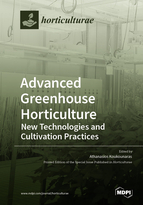Advanced Greenhouse Horticulture: New Technologies and Cultivation Practices
A special issue of Horticulturae (ISSN 2311-7524). This special issue belongs to the section "Protected Culture".
Deadline for manuscript submissions: closed (28 February 2019) | Viewed by 98074
Special Issue Editor
Interests: cultivation techniques for vegetable production; quality of vegetable products; hydroponic vegetable production; postharvest physiology of vegetables; role of light on vegetables’ growth; quality of seedlings; quality and seed germination; vegetable grafting; innovative forms of vegetable products; organic cultivation of vegetables
Special Issues, Collections and Topics in MDPI journals
Special Issue Information
Dear Colleagues,
Greenhouse horticulture production is among the most intensive agricultural systems, requiring high inputs from growers. However, production practices have been changing due to the use of new technologies, increasing sensitivity to environmental issues, and consumer concerns about product quality, nutritional value (e.g., health-beneficial compound content), and safety (e.g., nitrate content), as well as adaptation to negative impacts of climate change.
The purpose of this Special Issue “Advanced Greenhouse Horticulture: New Technologies and Cultivation Practices” is to present innovative studies, tools, approaches, and techniques that have been successful in addressing some of these concerns, such as use of shadow nets, new substrates, floating systems, closed soiless growing systems, LED lighting, microenvironment modification, energy-saving technologies, soil and media health and properties, role of propagation material (traditional varieties, grafting, etc.), and any other innovation that has improved the efficiency and sustainability of greenhouse horticultural crops, for the production of high quality commodities.
Dr. Athanasios Koukounaras
Guest Editor
Manuscript Submission Information
Manuscripts should be submitted online at www.mdpi.com by registering and logging in to this website. Once you are registered, click here to go to the submission form. Manuscripts can be submitted until the deadline. All submissions that pass pre-check are peer-reviewed. Accepted papers will be published continuously in the journal (as soon as accepted) and will be listed together on the special issue website. Research articles, review articles as well as short communications are invited. For planned papers, a title and short abstract (about 100 words) can be sent to the Editorial Office for announcement on this website.
Submitted manuscripts should not have been published previously, nor be under consideration for publication elsewhere (except conference proceedings papers). All manuscripts are thoroughly refereed through a single-blind peer-review process. A guide for authors and other relevant information for submission of manuscripts is available on the Instructions for Authors page. Horticulturae is an international peer-reviewed open access monthly journal published by MDPI.
Please visit the Instructions for Authors page before submitting a manuscript. The Article Processing Charge (APC) for publication in this open access journal is 2200 CHF (Swiss Francs). Submitted papers should be well formatted and use good English. Authors may use MDPI's English editing service prior to publication or during author revisions.
Keywords
- product quality
- soiless systems
- climate control
- supplementary/artificial lighting






